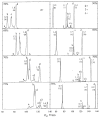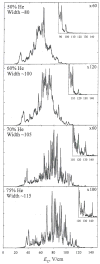High-resolution differential ion mobility separations using helium-rich gases
- PMID: 20151640
- PMCID: PMC2945891
- DOI: 10.1021/ac902852a
High-resolution differential ion mobility separations using helium-rich gases
Abstract
Analyses of complex mixtures and characterization of ions increasingly involve gas-phase separations by ion mobility spectrometry (IMS) and particularly differential or field asymmetric waveform IMS (FAIMS) based on the difference of ion mobility in strong and weak electric fields. The key advantage of FAIMS is substantial orthogonality to mass spectrometry (MS), which makes FAIMS/MS hybrid a powerful analytical platform of broad utility. However, the potential of FAIMS has been constrained by limited resolution. Here, we report that the use of gas mixtures comprising up to 75% He dramatically increases the FAIMS separation capability, with the resolving power for peptides and peak capacity for protein digests reaching and exceeding 100. The resolution gains extend to small molecules, where previously unresolved isomers can now be separated. These performance levels open major new applications of FAIMS in proteomic and other biomolecular analyses.
Figures






Similar articles
-
High-resolution differential ion mobility separations using planar analyzers at elevated dispersion fields.Anal Chem. 2010 Sep 15;82(18):7649-55. doi: 10.1021/ac101413k. Anal Chem. 2010. PMID: 20666414 Free PMC article.
-
Differential ion mobility separations of peptides with resolving power exceeding 50.Anal Chem. 2010 Jan 1;82(1):32-5. doi: 10.1021/ac902133n. Anal Chem. 2010. PMID: 19938817 Free PMC article.
-
Differential ion mobility separations in up to 100% helium using microchips.J Am Soc Mass Spectrom. 2014 Mar;25(3):480-9. doi: 10.1007/s13361-013-0797-4. Epub 2014 Jan 9. J Am Soc Mass Spectrom. 2014. PMID: 24402673 Free PMC article.
-
High-field asymmetric waveform ion mobility spectrometry for mass spectrometry-based proteomics.Expert Rev Proteomics. 2012 Oct;9(5):505-17. doi: 10.1586/epr.12.50. Expert Rev Proteomics. 2012. PMID: 23194268 Free PMC article. Review.
-
Ion mobility-mass spectrometry.J Mass Spectrom. 2008 Jan;43(1):1-22. doi: 10.1002/jms.1383. J Mass Spectrom. 2008. PMID: 18200615 Review.
Cited by
-
Ion mobility-mass spectrometry: time-dispersive instrumentation.Anal Chem. 2015 Feb 3;87(3):1422-36. doi: 10.1021/ac504720m. Epub 2015 Jan 9. Anal Chem. 2015. PMID: 25526595 Free PMC article. Review. No abstract available.
-
Resolution enhancement of field asymmetric waveform ion mobility spectrometry (FAIMS) by ion focusing.Chem Cent J. 2013 Jul 12;7(1):120. doi: 10.1186/1752-153X-7-120. Chem Cent J. 2013. PMID: 23849221 Free PMC article.
-
Conformational distribution of bradykinin [bk + 2 H]2+ revealed by cold ion spectroscopy coupled with FAIMS.J Am Soc Mass Spectrom. 2012 Jul;23(7):1173-81. doi: 10.1007/s13361-012-0384-0. Epub 2012 Apr 18. J Am Soc Mass Spectrom. 2012. PMID: 22528205
-
Improved isobaric tandem mass tag quantification by ion mobility mass spectrometry.Rapid Commun Mass Spectrom. 2014 May 15;28(9):1051-1060. doi: 10.1002/rcm.6875. Rapid Commun Mass Spectrom. 2014. PMID: 24677527 Free PMC article.
-
High-definition differential ion mobility spectrometry with resolving power up to 500.J Am Soc Mass Spectrom. 2013 Jan;24(1):109-14. doi: 10.1007/s13361-012-0517-5. Epub 2012 Dec 20. J Am Soc Mass Spectrom. 2013. PMID: 23345059 Free PMC article.
References
-
- Aebersold R, Mann M. Nature. 2003;422:198–207. - PubMed
-
- Mason EA, McDaniel EW. Transport Properties of Ions in Gases. Wiley; New York: 1988.
-
- Eiceman GA, Karpas Z. Ion Mobility Spectrometry. CRC Press; Boca Raton, FL: 2005.
-
- Shvartsburg AA. Differential Ion Mobility Spectrometry. CRC Press; Boca Raton, FL: 2008.
-
- Ruotolo BT, Giles K, Campuzano I, Sandercock AM, Bateman RH, Robinson CV. Science. 2005;310:1658–1661. - PubMed
Publication types
MeSH terms
Substances
Grants and funding
LinkOut - more resources
Full Text Sources
Other Literature Sources

